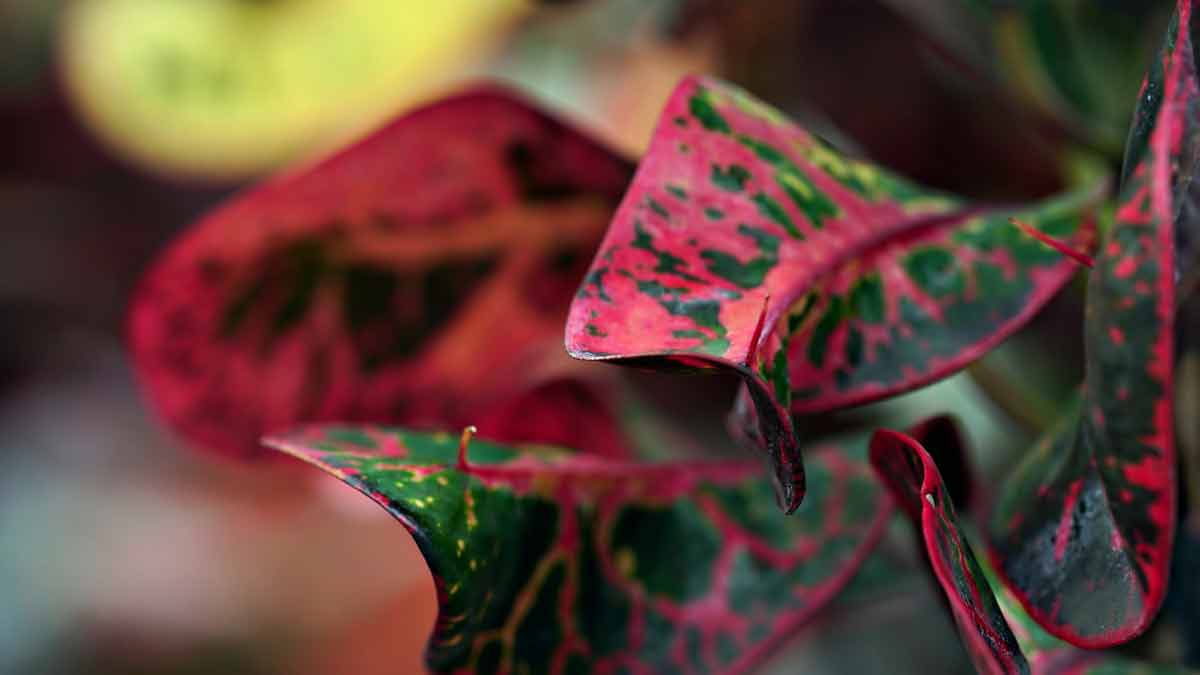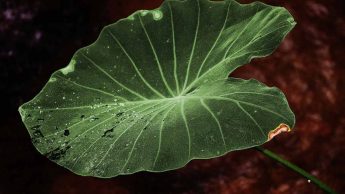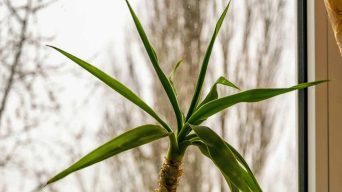Croton plants are sensitive to overwatering, which causes wilting and yellowing of leaves. To save an overwatered croton, stop watering it, let the soil dry out completely, and repot it in well-draining soil. Wilting and yellowing leaves indicate overwatering, while dry, falling leaves mean underwatering.
With their vibrant and colorful leaves, Croton plants add a touch of tropical charm to any indoor space.
However, these stunning beauties can be sensitive to overwatering, which may lead to various issues such as root rot and drooping leaves.
Here we’ll help you identify the signs of an overwatered Croton plant and provide a step-by-step guide to nurse it back to health.
Identifying Signs Of Overwatering In A Croton Plant
If you’re a plant parent and have a Croton plant, carefully monitoring its watering needs is essential.
Overwatering can harm the plant’s health and cause several visible signs, such as drooping, yellowing, or browning of leaves and root rot.
Therefore, it’s crucial to identify the signs of overwatering in a Croton plant to avoid further damage and provide it with the care it needs.
Wilting, Drooping Leaves
Wilting and drooping leaves are common signs of an overwatered Croton plant.
This may seem counterintuitive, as wilting is often associated with a lack of water rather than too much.
However, when crotons receive excessive water, their roots can suffocate and starve for oxygen.
In some situations, underwatering or low humidity could also cause wilting or drooping leaves on your indoor Croton plants.
To accurately diagnose the issue, examine other factors, such as soil moisture levels and overall leaf health, before taking action.
For instance, overwatered Crotons typically exhibit yellowing leaves alongside wilted ones.
In contrast, brown leaf tips with crisp texture might indicate underwatering instead.
Yellowing Or Browning Leaves
One of the most noticeable symptoms of an overwatered Croton plant is yellowing or browning leaves.
Overwatering leads to soggy soil, depriving the roots of oxygen and inhibiting their ability to absorb nutrients effectively.
As a result, the Croton leaves begin to show signs of stress by turning yellow or brown.
There have been instances where passionate gardeners mistakenly attribute this symptom to a lack of nutrients and add even more water to solve the issue, exacerbating the problem further.
To avoid causing further damage to your overwatered Croton, it’s crucial first to understand that Codiaeum variegatum needs well-draining soil and moderate watering practices for healthy leaf growth.
Root Rot
Root rot is a common but daunting problem for plant enthusiasts, especially when dealing with overwatered croton plants.
This troublesome condition occurs when excess water and poor drainage create a breeding ground for harmful fungi and bacteria that attack the roots of your beloved indoor plants.
When root rot strikes an overwatered croton plant, acting fast is essential.
The condition can spread from one affected plant to others within proximity or sharing pots if not contained promptly.
An excellent treatment option is using hydrogen peroxide diluted with water (1 part hydrogen peroxide to 4 parts water) on the affected roots before repotting into fresh soil; this helps kill off some harmful microbes while providing much-needed oxygen for healthier root growth.
Step-by-Step Guide To Saving An Overwatered Croton Plant
If you’ve overwatered your Croton plant, don’t despair!
There are steps you can take to save it.
The first thing to do is to stop watering it right away.
Next, check the root’s health by gently uprooting it.
Remove any standing water and allow the roots to dry out before repotting in fresh soil with proper drainage.
Follow these simple steps, and your Croton plant will have a good chance of recovering.
Stop Watering Immediately
If you notice signs of overwatering in your Croton plant, the first and most crucial step is to stop watering immediately.
Here are some tips on how to do it effectively:
- Remove the plant from its pot or move it away from any standing water.
- If there is excess water in the soil, gently press down on the soil to remove as much moisture as possible.
- Allow the plant to dry out completely before watering again. Depending on the severity of overwatering, this can take several days or even up to a week.
- Check the soil moisture level before watering again by sticking your finger about an inch deep into the soil. If it feels dry, it’s time to water.
Check Root Health And Remove Standing Water
One of the first steps in saving an overwatered Croton plant is to check its root health and remove any standing water.
Overwatering can lead to soggy soil, which suffocates the roots and prevents them from absorbing nutrients properly.
To check for root damage:
- Carefully uproot your Croton and inspect its roots.
- Trim away any mushy or blackened sections with clean scissors or shears.
- Once you’ve removed as much affected tissue as possible, replant your Croton in fresh soil with proper drainage holes so it doesn’t get oversaturated again.
Repot The Plant With Fresh, Well-Draining Soil
Repotting with fresh, well-draining soil is necessary to save an overwatered Croton plant.
Here are the steps to follow:
- Choose a pot that is one size larger than the current one and has drainage holes.
- Remove the plant from its old pot and gently loosen any tangled roots.
- Remove any dead or damaged roots.
- Fill the new pot with fresh, well-draining soil, leaving enough space for the plant’s root ball.
- Place the plant in the new pot and fill it with soil around it, pressing lightly to ensure firmness.
- Water thoroughly, but avoid saturating the soil, ensuring excess water can drain through the holes at the bottom of the pot.
Repotting your overwatered Croton plant will help it recover by providing fresh soil that can hold enough moisture without getting soggy.
Monitor its condition and adjust its watering schedule accordingly using tips outlined in this guide, such as monitoring soil moisture levels or avoiding excess water trapped in saucers or trays under pots to achieve proper care and maintenance for your plant.
Trim Away Dead Or Damaged Leaves And Roots
To save an overwatered Croton plant, it’s important to trim away any dead or damaged leaves and roots.
This will help the plant redirect its energy toward healthy growth.
Be sure to use sharp scissors or pruning shears to properly remove damaged or dead leaves, as blunt tools can damage the healthy parts of the plant.
If you notice brown leaf tips or spots, trim them with clean tools.
It’s important not to over-prune the Croton plant because it may cause stress, leading to more issues in the long run.
It’s good practice to check on your plants regularly to identify signs of trouble before they become bigger problems.
Adjust the Watering Schedule And Amount
To prevent overwatering your Croton plant, it’s essential to adjust your watering schedule and amount.
Here are some tips:
- Use well-draining soil: This type of soil allows adequate drainage and prevents water from accumulating in the potting mix.
- Water deeply but infrequently: Instead of watering your plant daily, give it a good soaking once a week. This will ensure that the roots receive enough moisture without being overwatered.
- Monitor soil moisture levels: Before watering your plant, check the soil’s moisture level with your finger or a moisture meter. If the top inch of soil is dry, it’s time to water.
- Avoid leaving excess water in saucers or trays: Empty any standing water in the saucer or tray immediately after watering to prevent root rot.
- Consider using distilled water: Using distilled water instead of tap water can prevent mineral buildup in the soil, which can affect plant growth.
Remember that every plant is different and may require different amounts of water depending on humidity, sunlight exposure, and temperature.
Tips For Properly Watering Croton Plants
Watering is crucial if you’re looking for tips to keep your Croton plants healthy.
Using the correct type of soil and watering technique is essential to avoid over or under-watering.
By watering deeply but infrequently, you can prevent the soil from becoming too wet, which can lead to root rot.
Additionally, monitoring soil moisture levels, avoiding excess water in trays, and using a moisture meter can help ensure your Croton plants receive the right amount of water they need.
Use Well-Draining Soil
When caring for Croton plants, using well-draining soil is crucial to prevent overwatering and root rot.
Here are some tips for selecting the right soil:
- Choose a high-quality potting mix designed for houseplants or tropical plants like Crotons.
- Look for soil mixes that contain perlite, vermiculite, or sand to improve drainage and aeration.
- Avoid using heavy soils that retain excessive moisture and can cause waterlogged roots.
- Add drainage material, such as coarse sand or perlite, to the pot’s bottom before adding soil.
- Make sure your pot has drainage holes to allow excess water to escape.
Water Deeply But Infrequently
One of the key tips for properly watering your Croton plant is to water deeply but infrequently.
This means giving your plant a good soak when watering it rather than lightly misting or spraying it.
However, you don’t want to overwater the plant and drown its roots.
A good rule of thumb is to water 1-3 times per week, depending on how quickly the soil dries out (use a moisture meter if needed).
Watering this way allows the roots to fully absorb moisture and nutrients from the soil without risking oversaturation.
As with most plants, it’s also essential to avoid leaving excess water in saucers or trays – this can lead to soggy soil and root rot.
Monitor Soil Moisture Levels
To ensure the health of your Croton plant, it’s crucial to monitor its soil moisture levels.
Here are some tips on how to do this effectively:
- Use a moisture meter: This handy tool can accurately read the soil moisture level any time.
- Check the soil visually: Stick your finger about an inch and see if it feels moist or dry.
- Lift the pot: If it feels heavy, there’s likely too much moisture in the soil, while a lighter pot suggests that it’s time for watering.
- Consider environmental factors: Your Croton plant may require more or less water than usual, depending on where you live and the time of year.
Regularly monitoring your Croton plant’s soil moisture levels can adjust your watering schedule accordingly and avoid over or under-watering.
Avoid Leaving Excess Water In Saucers Or Trays
One of the most common mistakes in caring for Croton plants is leaving excess water in saucers or trays.
This practice can lead to overwatering, which may cause root rot and ultimately result in your Croton plant dying.
Use well-draining soil to avoid overwatering your Croton plant through excess water accumulation.
When watering your plant, do not exceed its capacity; give it enough water until there’s little runoff from the bottom of the pot.
Remove any excess standing water within 30 minutes after watering by tipping the saucer or using a small towel.
Consider Using A Moisture Meter
If you struggle with overwatering your Croton plant, using a moisture meter can be valuable in preventing further damage.
Here are some reasons why:
- Accurate Readings: A moisture meter gives precise readings of the moisture level in the soil around your Croton roots. This removes any guesswork and helps ensure you’re not watering your plant too much or too little.
- Easy to Use: Moisture meters are straightforward and come in various styles. Some require sticking a probe into the soil, while others have sensors that detect the moisture level without disturbing the plant.
- Saves Money: By helping you avoid overwatering, a moisture meter can save you money on water bills and prevent you from replacing plants damaged by excess water.
- Prevents Root Rot: Overwatering can lead to root rot, which is challenging to treat once it sets in. A moisture meter can help avoid this issue by alerting you when the soil is too saturated.
- Helps Balance Light and Water Needs: Croton plants need bright light but not lots of water. A moisture meter can help you balance these needs by ensuring your Croton isn’t sitting in soggy soil or drying out between waterings.
Overall, using a moisture meter effectively prevents overwatering and ensures that your Croton plant has enough moisture for optimal growth and health.
Final Thoughts
Don’t let overwatering get the best of your precious Croton plant!
You can rescue your drooping and wilting plant with a little bit of attention and care.
Remember to check for signs of overwatering and adjust your watering schedule accordingly.
Repotting with fresh soil and trimming damaged leaves and roots are key steps in reviving an overwatered Croton.
Keep in mind the proper lighting conditions, soil type, and humidity levels for your plant’s optimum health.







